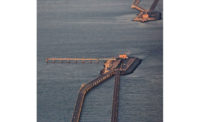The signing of large infrastructure contracts usually is followed by hectic activity. By contrast, the winning of contracts for the Femern Link, an $8-billion European program to construct the world’s longest immersed-tube tunnel, has been followed by a period of quiet. Designed to connect Denmark and Germany and open for traffic in 2028, the 18-kilometer-long design-build project is in hibernation while permitting on the German side makes slow progress.
International firms such as Copenhagen-based COWI A/S, which became the contractors’ lead design consultant this past March, are keen to get on with the massive underwater tunnel. It is among the largest-ever Danish infrastructure jobs and “one of the biggest-ever projects won by the company,” says Lars-Peter Søbye, COWI’s president and CEO. Winning the design contract “means we have taken all [Denmark’s] fixed links … this was a must-win,” he adds.
Previously, COWI played a major role on Denmark’s two other large sea fixed links, the Great Belt and Øresund. While supporting the contractor’s successful bids for the Femern tunnel, COWI fielded about 30 staff, and when full design begins, the numbers will swell to about 150. But, for now, the team is dormant while Femern A/S (FA/S), the Danish government’s Copenhagen-based project owner, attempts to secure planning approvals from the German authorities.
Major construction firms lie in wait, as well. FA/S on May 30 signed four design-build contracts, worth almost $4.6 billion total and covering the north and south tunnel sections, portals and ramps, and dredging. Until Germany gives final approval, the contracts remain conditional, with break clauses allowing for a review in 2019.
Seventy-nine, 217-meter-long precast-concrete elements weighing about 73,000 tonnes each will be strung together to form the immersed tunnel in a pre-dredged trench. In an unusual move, crews will insert ten 40-m-long, two-level special elements between every eighth standard unit to house equipment and provide space for maintenance crews to park their vehicles without disrupting traffic.
With four road lanes and two rail tracks, the $8-billion link will run between the islands of Lolland, Denmark, and Fehmarn, Germany. Directly linking Scandinavia and Central Europe, it will cut travel time between Copenhagen and Hamburg by about 2.5 hours. However, the project’s completion date is still unknown.
“The beauty of an immersed tube tunnel is that it’s a mixture of tunnel work, marine work, and structural and civil work,” says Lars Hauge, COWI’s regional vice president and head of bridges, tunnels and marine.
COWI, which ranks at No. 32 in ENR’s Top 225 International Design Firms (see p. 59), can draw on staff in Denmark, the U.K., the Middle East, North America and India. “You need the right people, so you tend to work with distributed engineering,” explains Jotham Vizard, the firm’s vice president and head of tunnels.
Having completed in the past 20 years the 18-km-long Great Belt bridge and tunnel, which runs between Zealand and Funen, and the 16-km Øresund Denmark-Sweden crossing, the Danes were more relaxed than the Germans about launching such a major link, believes Peter Lundhus, a consultant and, until last year, the FA/S technical director. The Danish authorities “had all been involved and had acquired knowledge that was very necessary,” says Lundhus. Their German counterparts “all started with no knowledge—there was no clear line of shared responsibility among the many institutions.”

It is “one of the biggest-ever projects won by the company.”
–Lars-Peter Søbye, COWI President and CEO
The Danish-Swedish partnership style used on Øresund was not a good fit for Femern. “Such a decision could not be made between all the many states in Germany,” says Lundhus. So, the Danes agreed to finance and procure the whole link themselves, including a few kilometers of road and rail on the German side.
Learning from the two previous projects, a corps of Danish engineers is carrying its experience to Femern. For example, COWI’s Hauge set out 25 years ago as a design engineer on the Great Belt’s suspension bridge. When COWI was recruited by the Øresund cable-stayed-bridge contractors, he became design manager.
On the owner’s side, Henrik Christensen started out with one of the design firms doing rebar calculations on the Great Belt. On Øresund, he was the bridge design manager for the project owner, an affiliate of FA/S. He is now FA/S’s interim technical director.
His predecessor in that post was Lundhus. He stood down in January 2015 to avoid potential conflicts of interest, as his son Christian was likely to become the project director with one of the bidders for the portals-and-ramps contract. “My future is behind me,” says the 73-year-old engineer.
Since leaving a London-based contractor in 1988 to become the owner’s project director on the Great Belt, Lundhus has held senior posts on all three projects. Four years later, he moved within the organization to become the technical director and “the first employee” on the Øresund project.
After Øresund, Lundhus in 2000 set up a small team to investigate the potential of private financing for the Femern Link, an idea that was ruled out. Next, he led studies into bridge and tunnel options for the crossing.

First offers “came in $1.3 billion above our estimate.”
–Henrik Christensen, FA/S Interim Technical Director
From several teams of design firms bidding for the option studies, FA/S in April 2009 recruited the RAT joint venture to investigate tunnels. Led by Denmark’s Ramboll Group, RAT includes the U.K.’s Arup Group and immersed-tunnel specialist Tunnel Engineering Consultants, the Netherlands.
RAT went on to develop illustrative designs, which were used for the tunnel constructing bids, and it helped to evaluate contractors’ submissions. It is now supporting the owner in its permitting process in Germany.
“In the first three years, [our staffing] was in the range of 50 or 60 full-time equivalents,” says Susanne Kalmar Pedersen, project director with Ramboll. The team will help to monitor construction when it starts.
In winning the bridge-option study, COWI was less lucky. “We were confident it was going to be a bridge,” says Hauge. “On a narrow technical perspective, the bridge should have been the preferred option.” But “it would have been very, very difficult to get a bridge solution through in Germany with all their [environmental] resistance,” he adds.
In late 2010, FA/S recommended an immersed tunnel. A bridge, with two record-breaking 724-m spans, would have been a greater navigation hazard and more vulnerable to weather, the owner concluded. An assessment of tunnel options ruled out a bored crossing, partly because of its 24% higher cost and longer construction schedule. While an immersed tunnel relied on proven technology, the bored option in Femern’s ground would have been difficult and required the world’s largest TBMs.
Having failed to secure a contract with the tunnel owner, COWI later negotiated a place on the bidding teams of Femern Link Contractors (FLC). The consortium won the three main design-build contracts. The fourth, which involves dredging work, went to the Fehmarn Belt Contractors (FBC) team.
FA/S kicked off the construction bidding in October 2012, inviting contractors to prequalify. Nine consortiums went on to submit 17 technical bids in April 2014. Preliminary financial offers in December 2014 “came in $1.3 billion above our estimate,” says Christensen.
In the so-called “competitive dialogue” that followed, the owner and contractors cut the excess by around 75%. The competitive dialogue is a procedure that allows for simultaneous and identical negotiations between the owner and competing contractors, he explains. The process led to a revised final bid last September.

The beauty of immersed tubes? “It’s a mixture of tunnel, marine, and structural and civil work.”
–Lars Hauge, COWI Regional VP
Cost-saving measures included extending the construction period to 8.5 years from 6.5 years, which took early pressure off dredging contractors and allowed tunnel bidders to reduce the number of big-element casting bays to five or six from eight, Christensen says. Costs also were cut by allowing differently sized rock for armoring. The owner realized additional savings by reducing the quality of the tunnel trench’s 16 million to 19 million cu m of dredged material to reclaim some 330 hectares of shoreline at Lolland, Denmark, says Christensen. The speed of settlement was not critical, he adds.
For the tunnel, contractors separately bid the north and south packages. But, in case of winning both, they were free to offer a discount for savings made by combining the management teams. FA/S named four preferred bidders this March, before conditionally signing their contracts at the end of May.
The winning contractors’ teams involve major international firms from all over Europe. Securing the north and south tunnel contracts is FLC, an eight-firm consortium led by Paris-based VINCI Construction Grands Projets S.A.S. The team’s Denmark-based Per Aarsleff Holding A/S leads the third contract, covering tunnel portals and ramps. Leading FBC, the four-firm Dutch-German consortium, is Boskalis, which nabbed the fourth contract for dredging and reclamation.
If Germany approves the scheme in 2019, construction could start the following year and end in 2028, according to FA/S. But in the absence of approvals by mid-2019, the contracts will be renegotiated or rebid.

German procedures are “very bureaucratic.”
–Peter Lundhus, Consultant and Former FA/S Technical Director
First signs of permitting snags appeared in April 2012, when FA/S delayed the project for a year. The need for coordination between the Danes and Germans “is greater than we had expected,” explained Leo Larsen, then CEO. Even then, official hopes for German approvals by 2015 were too optimistic.
In October 2013, FA/S lodged an 11,000-page planning application with Germany’s Schleswig-Holstein state. Following consultations, revised documents were resubmitted this February. Meanwhile, in April 2015, Denmark’s parliament passed the project’s construction act, granting FA/S necessary local powers to go ahead.
German procedures involve numerous organizations and are “very bureaucratic,” says Lundhus. For example, it took four years to secure planning approval for a six-month dredging job, he says.
This planning practice not only extended the project’s gestation but also reduced the leeway available to the design-build contractors. “It’s very difficult, but not impossible, to combine design and construct with the German approvals process. You have no [such] problems on the Danish side,” says Lundhus.
Preparing documents for the German process is “a design project in its own right,” says Pedersen. “In many ways, the design is quite locked.” The German authorities “aren’t very familiar with the design-build process. They are used to getting everything in a lot of detail.”
COWI and other Danish firms hope Femern’s opening will show that a tiny country with under five million people can successfully tackle two major sea links and launch a potentially record-breaking third.
Danish design firms “have benefitted tremendously” from the earlier Great Belt and Øresund projects, says Lundhus. “They would not have achieved the level they have today without these two projects.”








Post a comment to this article
Report Abusive Comment